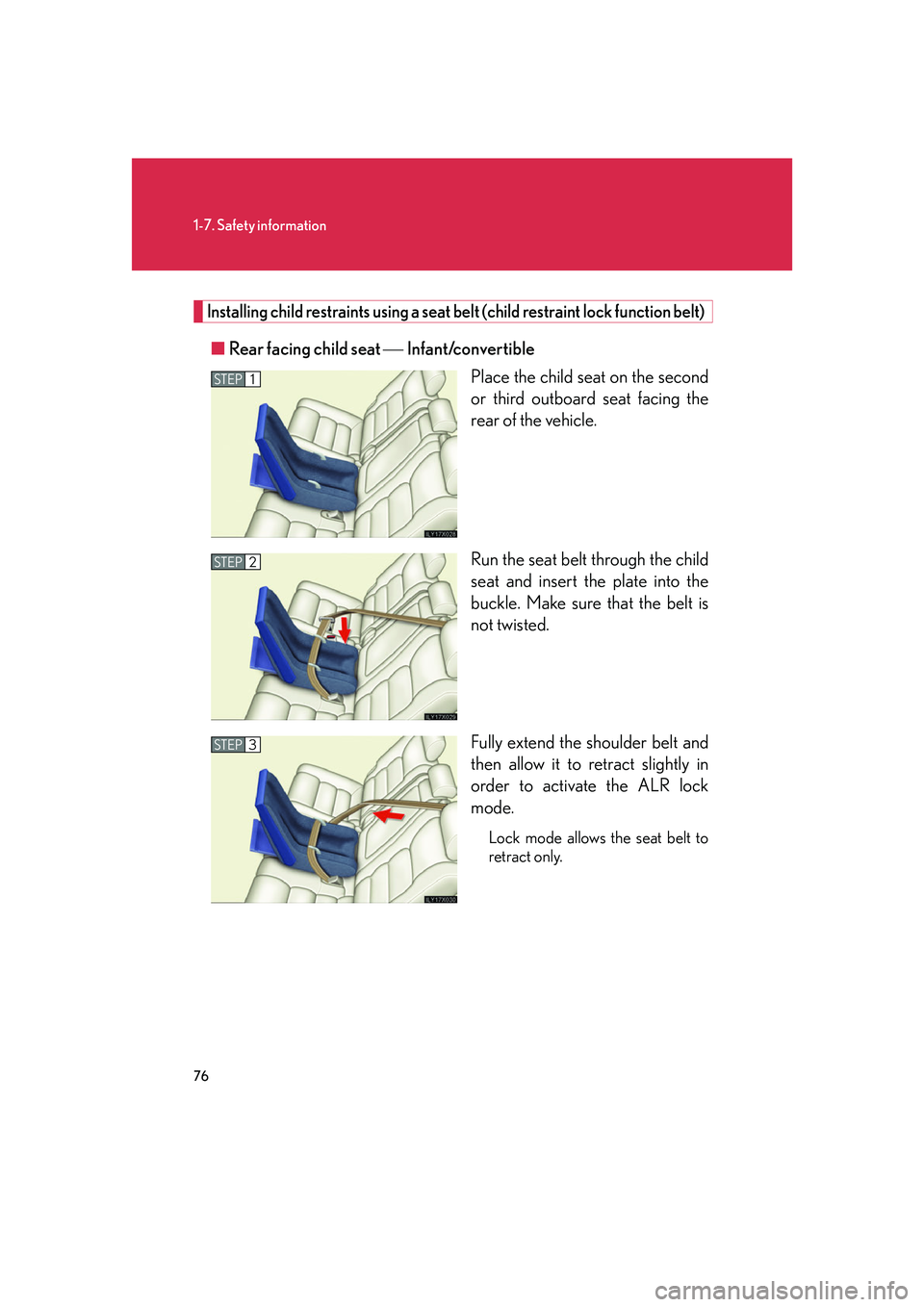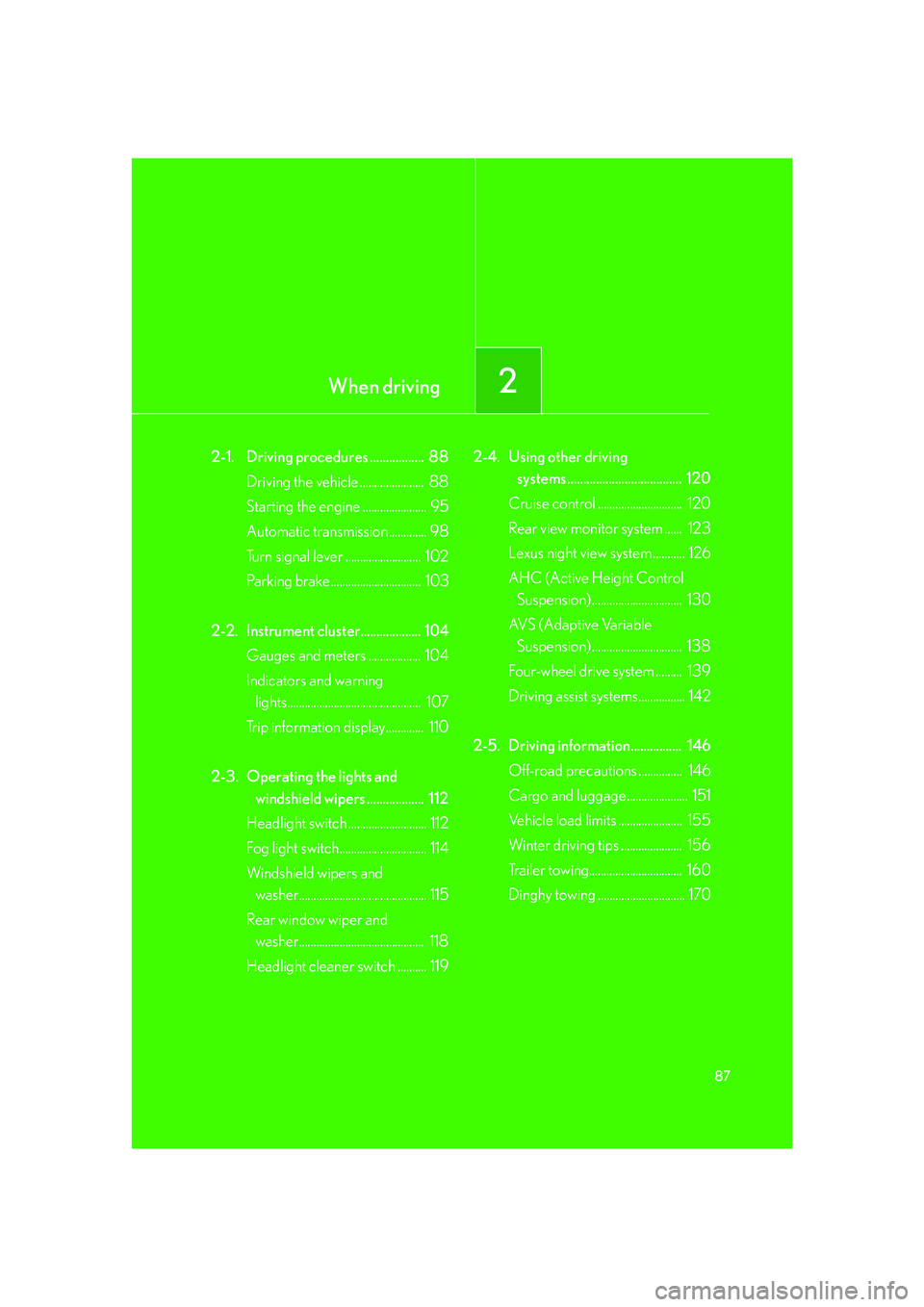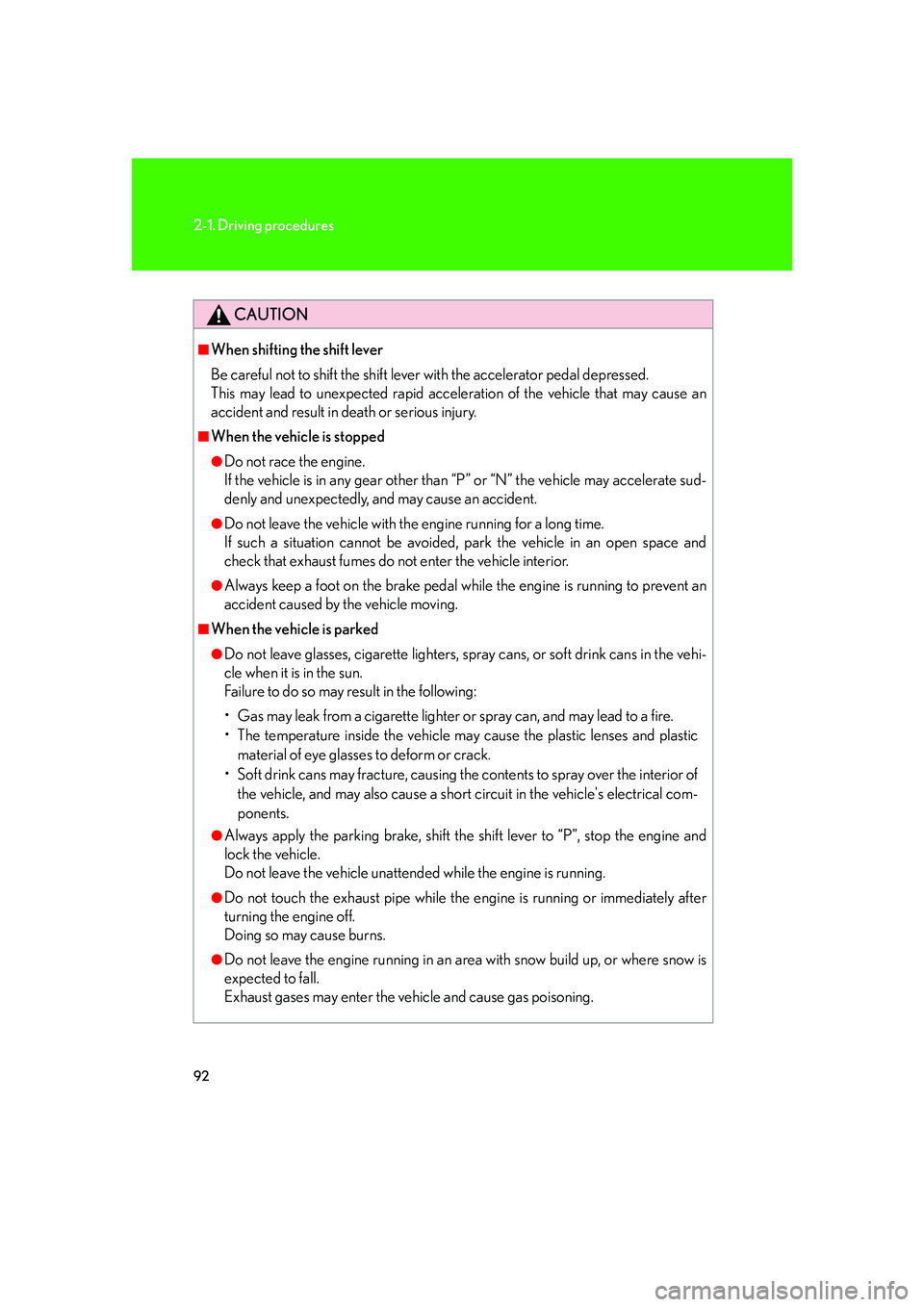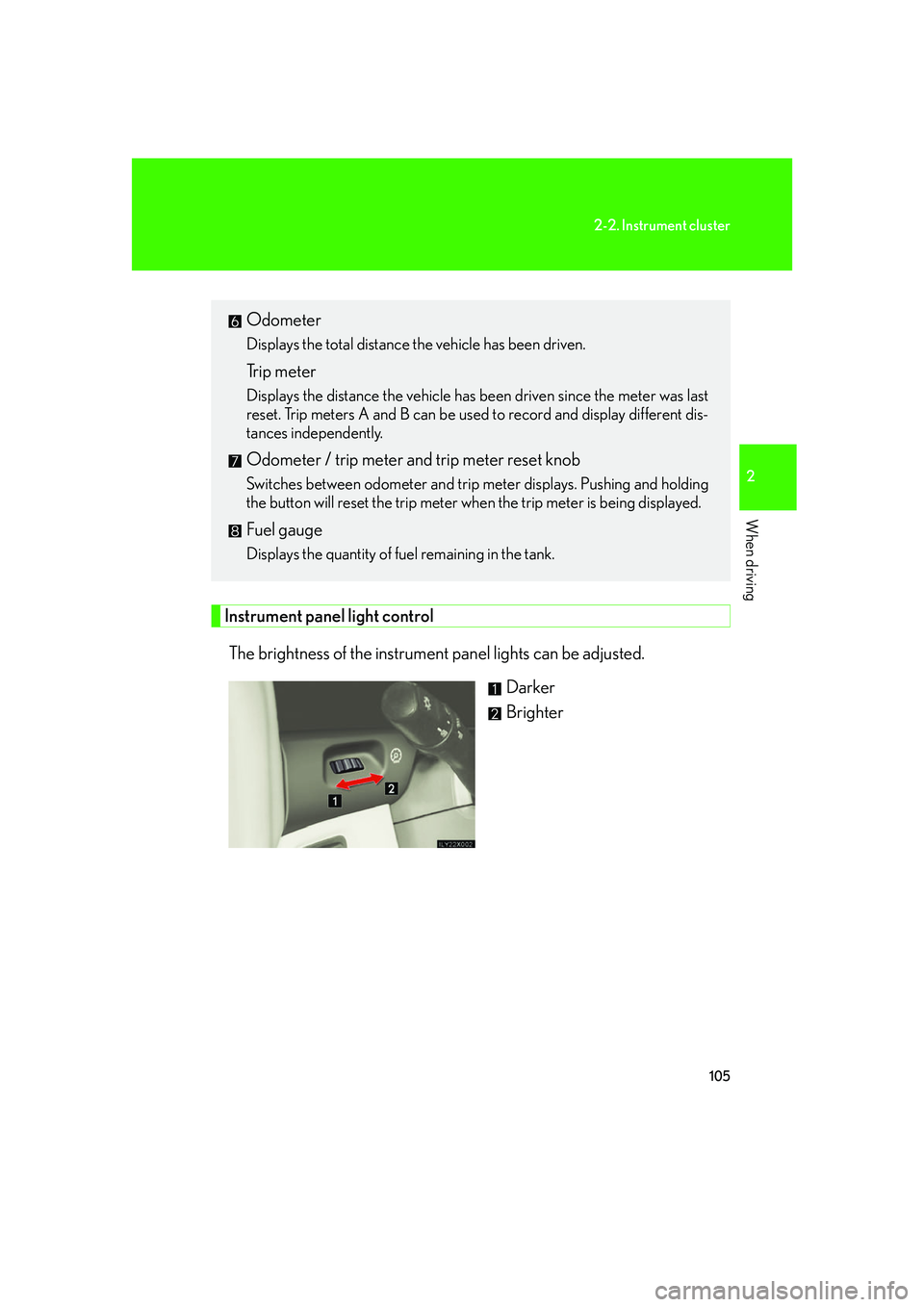light LEXUS LX470 2007 Owner's Guide
[x] Cancel search | Manufacturer: LEXUS, Model Year: 2007, Model line: LX470, Model: LEXUS LX470 2007Pages: 426, PDF Size: 10.95 MB
Page 89 of 426

71
1-7. Safety information
1
Before driving
CAUTION
■Front passenger occupant classification system precautions
●If an adult sits in the front passenger se at, the AIRBAG ON indicator light is illu-
iminated. If the AIRBAG OFF indicator is illuminated, ask the passenger to sit up
straight, well back in the seat, feet on the floor, and with the seat belt worn cor-
rectly. If the AIRBAG OFF indicator still remain illuminated, either ask the pas-
senger to move to the second seat, or if that is not possible, move the front
passenger seat fully rearward.
●When it is unavoidable to install the forw ard-facing child restraint system on the
front passenger seat, install the child rest raint system on the front passenger seat
in the proper order. ( P. 7 5 )
●Do not remove the front seat.
●Do not kick the front passenger seat or subject it to severe impact. Otherwise,
the SRS warning light may come on to in dicate a malfunction on the detection
system. In this case, contact your Lexus dealer immediately.
●Child restraint systems installed on the second seat should not contact the front
seat backs.
Page 92 of 426

74
1-7. Safety information
CAUTION
■Child restraint precautions
●For effective protection in automobile accidents and sudden stops, a child must
be properly restrained, using a seat belt or child restraint system depending on
the age and size of the child. Holding a child in your arms is not a substitute for a
child restraint system. In an accident, th e child can be crushed against the wind-
shield, or between you and the vehicle's interior.
●Lexus strongly urges the use of a proper child restraint system that conforms to
the size of the child, installed on the rear seat. According to accident statistics, the
child is safer when properly restrained in the rear seat than in the front seat.
●Never install a rear-facing child restraint system on the front passenger seat even
if the AIRBAG OFF indicator light illuminat es. In the event of an accident, the
force of the rapid inflation of the front passenger airbag can cause death or seri-
ous injury to the child if the rear-facing child restraint system is installed on the
front passenger seat.
●A forward-facing child restraint system shou ld allowed to be installed on the front
passenger seat only when it is unavoidable. Always move the seat as far back as
possible even if th e AIRBAG OFF indicator light i lluminates, because the front
passenger airbag could inflate with considerable speed and force. Otherwise,
the child may be killed or seriously injured.
●Do not use the seat belt extender when installing a child restraint system on the
front or rear passenger seat. If installing a child restraint system with the seat belt
extender connected to the seat belt, the seat belt will not securely hold the child
restraint system, which could cause death or serious injury to the child or other
passengers in the event of collision.
●Do not allow the child to lean his/her head or any part of his/her body against the
door or the area of the seat, front pillar or roof side rail from which the side air-
bags or curtain shield airbags deploy even if the child is seated in the child
restraint system. It is dangerous if the side airbags and curtain shield airbags
inflate, and the impact could cause death or serious injury to the child.
●Make sure you have complied with all inst allation instructions provided by the
child restraint manufacturer and that the sy stem is properly secured. If it is not
secured properly, it may cause death or seri ous injury to the child in the event of a
sudden stop or accident.
Page 94 of 426

76
1-7. Safety information
Installing child restraints using a seat belt (child restraint lock function belt)
■Rear facing child seat Infant/convertible
Place the child seat on the second
or third outboard seat facing the
rear of the vehicle.
Run the seat belt through the child
seat and insert the plate into the
buckle. Make sure that the belt is
not twisted.
Fully extend the shoulder belt and
then allow it to retract slightly in
order to activate the ALR lock
mode.
Lock mode allows the seat belt to
retract only.
STEP1
STEP2
STEP3
Page 95 of 426

77
1-7. Safety information
1
Before driving
While pushing the child seat down
into the seat, allow the shoulder
belt to retract until the child seat is
securely in place.
After the shoulder belt has
retracted to a point where there is
no slack in the belt, pull the belt to
check that it cannot be extended.
■Forward facing Convertible child seat
Place the child seat on the seat
facing the front of the vehicle.
Run the seat belt through the child
seat and insert the plate into the
buckle. Make sure that the belt is
not twisted.
Fully extend the shoulder strap and
then allow it to retract slightly into
the ALR lock mode.
Lock mode allows the seat belt to
retract only.
STEP4
STEP1
STEP2
STEP3
Page 102 of 426

84
1-7. Safety information
CAUTION
■When installing a child restraint system
Follow the directions given in the child restraint system installation manual and fix
the child restraint system securely in place.
If the child restraint system is not correctly fixed in place, the child may be seriously
injured or even killed in the even t of sudden braking or an accident.
●When a booster seat is installed, always ensure that the shoulder belt is posi-
tioned across the center of the child's shoulder. The belt should be kept away
from the child's neck, but not so that it could fall off the child's shoulder. Failing to
do so may result in death or serious inju ry in the event of an accident or sudden
braking.
●Ensure the belt and tab are securely locked and that the seat belt is not twisted.
●Push and pull the child seat in different directions to be sure it is secure.
●Follow all installation instructions provid ed by the child restraint system manufac-
turer.
●If the driver’s seat interferes with the child
restraint system and prevents it from being
attached correctly, attach the child restraint
system to the right-hand rear seat.
●Child restraint system installed on the third
seat should not cont act the second seat-
backs.
●Only put a forward facing or booster child
seat on the front seat when unavoidable.
When installing a forward facing or
booster child restraint on the front passen-
ger seat, move the seat as far back as possi-
ble even if the AIRBAG OFF indicator light
illuminates. Failing to do so may result in
death or serious injury if the airbags deploy
(inflate).
Page 105 of 426

When driving2
87
2-1. Driving procedures ................. 88Driving the vehicle ...................... 88
Starting the engine ...................... 95
Automatic transmission ............. 98
Turn signal lever .......................... 102
Parking brake ............................... 103
2-2. Instrument cluster................... 104 Gauges and meters .................. 104
Indicators and warning lights.............................................. 107
Trip information display............. 110
2-3. Operating the lights and windshield wipers .................. 112
Headlight switch ........................... 112
Fog light switch.............................. 114
Windshield wipers and washer............................................ 115
Rear window wiper and washer........................................... 118
Headlight cleaner switch .......... 119 2-4. Using other driving
systems .................................... 120
Cruise control ............................. 120
Rear view monitor system ...... 123
Lexus night view system ........... 126
AHC (Active Height Control Suspension) ............................... 130
AVS (Adaptive Variable Suspension) ............................... 138
Four-wheel drive system ......... 139
Driving assist systems................ 142
2-5. Driving information................ 146 Off-road precautions ............... 146
Cargo and luggage..................... 151
Vehicle load limits ...................... 155
Winter driving tips ..................... 156
Trailer towing................................ 160
Dinghy towing .............................. 170
Page 110 of 426

92
2-1. Driving procedures
CAUTION
■When shifting the shift lever
Be careful not to shift the shift lever with the accelerator pedal depressed.
This may lead to unexpected rapid acceleration of the vehicle that may cause an
accident and result in death or serious injury.
■When the vehicle is stopped
●Do not race the engine.
If the vehicle is in any gear other than “P” or “N” the vehicle may accelerate sud-
denly and unexpectedly, and may cause an accident.
●Do not leave the vehicle with the engine running for a long time.
If such a situation cannot be avoided, park the vehicle in an open space and
check that exhaust fumes do not enter the vehicle interior.
●Always keep a foot on the brake pedal while the engine is running to prevent an
accident caused by the vehicle moving.
■When the vehicle is parked
●Do not leave glasses, cigarette lighters, spray cans, or soft drink cans in the vehi-
cle when it is in the sun.
Failure to do so may result in the following:
• Gas may leak from a cigarette lighter or spray can, and may lead to a fire.
• The temperature inside the vehicle may cause the plastic lenses and plastic material of eye glasses to deform or crack.
• Soft drink cans may fracture, causing the contents to spray over the interior of the vehicle, and may also cause a short circuit in the vehicle's electrical com-
ponents.
●Always apply the parking brake, shift the shift lever to “P”, stop the engine and
lock the vehicle.
Do not leave the vehicle unattend ed while the engine is running.
●Do not touch the exhaust pipe while the engine is running or immediately after
turning the engine off.
Doing so may cause burns.
●Do not leave the engine running in an area with snow build up, or where snow is
expected to fall.
Exhaust gases may enter the vehicle and cause gas poisoning.
Page 114 of 426

96
2-1. Driving procedures
T■Steering lock release
■ If the engine does not start
The engine immobilizer system may not have been deactivated. (P. 4 7 )
■Starting the engine using the flat key
Put the key case away when the indicator light goes out. This means the
engine immobilizer system has turned off.
Start the engine within 60 seconds after the indicator light goes off.
When starting the engine, the ignition switch
may seem stuck in the “LOCK” position. To
free it, turn the ignition key while turning the
steering wheel sightly in either direction.
Remove the flat key from its case. Insert the
key into the ignition switch. STEP1
Bring the key case close to the ignition switch
within 10 seconds as indicated by an arrow. STEP2
STEP3
STEP4
Page 120 of 426

102
2-1. Driving procedures
Turn signal lever
■Turn signals can be operated when
The ignition key is in the “ON” position.
■If the indicators flash faster than usual
Check that a light bulb in the front or rear turn signal lights has not burned out.
Left turn
Right turn
Move and hold the lever part-
way to signal a lane change
The left hand signal will flash
until you release the lever.
Move and hold the lever part-
way to signal a lane change
The right hand signal will flash
until you release the lever.
Page 123 of 426

105
2-2. Instrument cluster
2
When driving
Instrument panel light controlThe brightness of the instrument panel lights can be adjusted. Darker
Brighter
Odometer
Displays the total distance the vehicle has been driven.
Trip meter
Displays the distance the vehicle has been driven since the meter was last
reset. Trip meters A and B can be used to record and display different dis-
tances independently.
Odometer / trip meter and trip meter reset knob
Switches between odometer and trip meter displays. Pushing and holding
the button will reset the trip meter when the trip meter is being displayed.
Fuel gauge
Displays the quantity of fuel remaining in the tank.